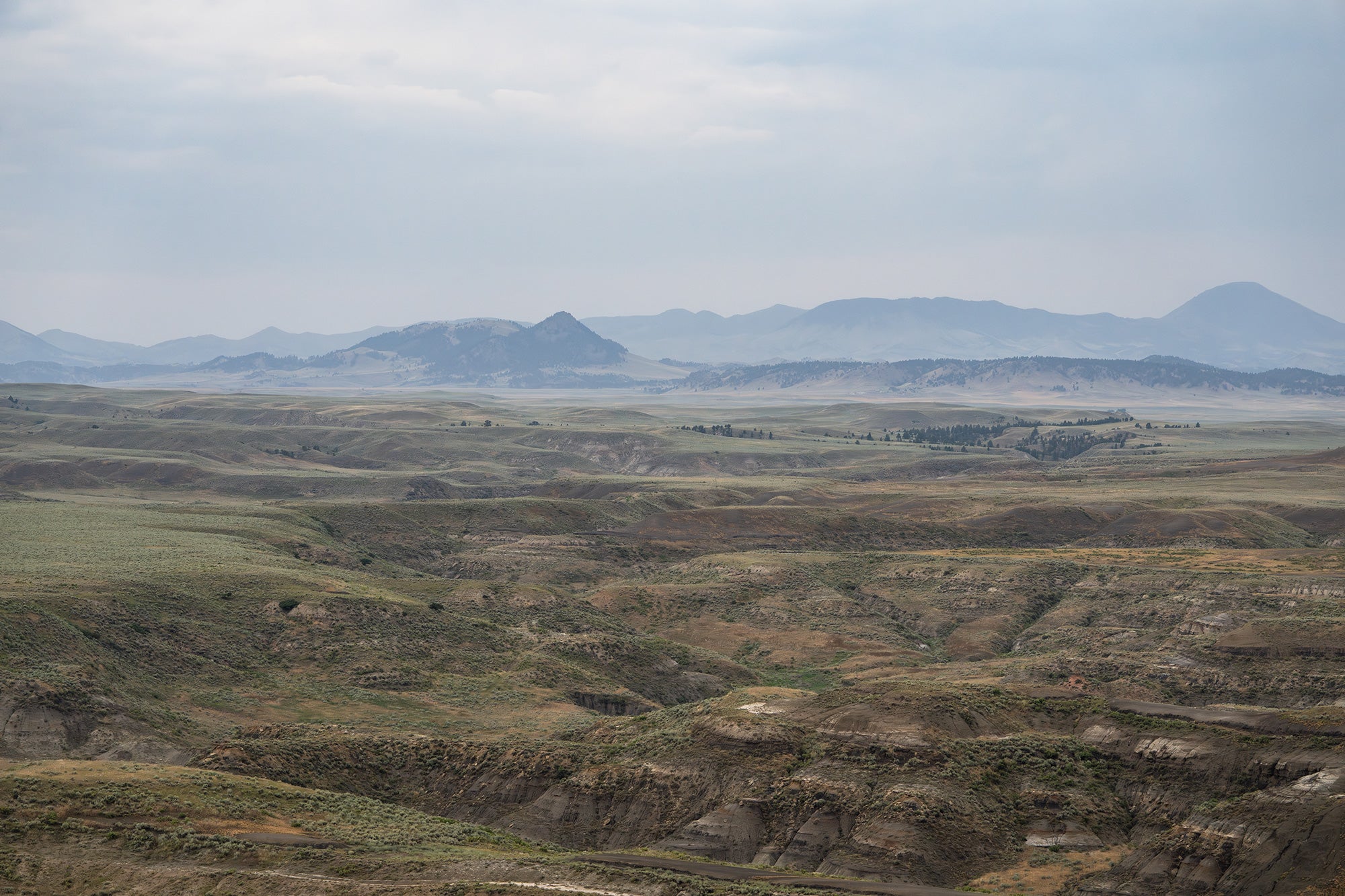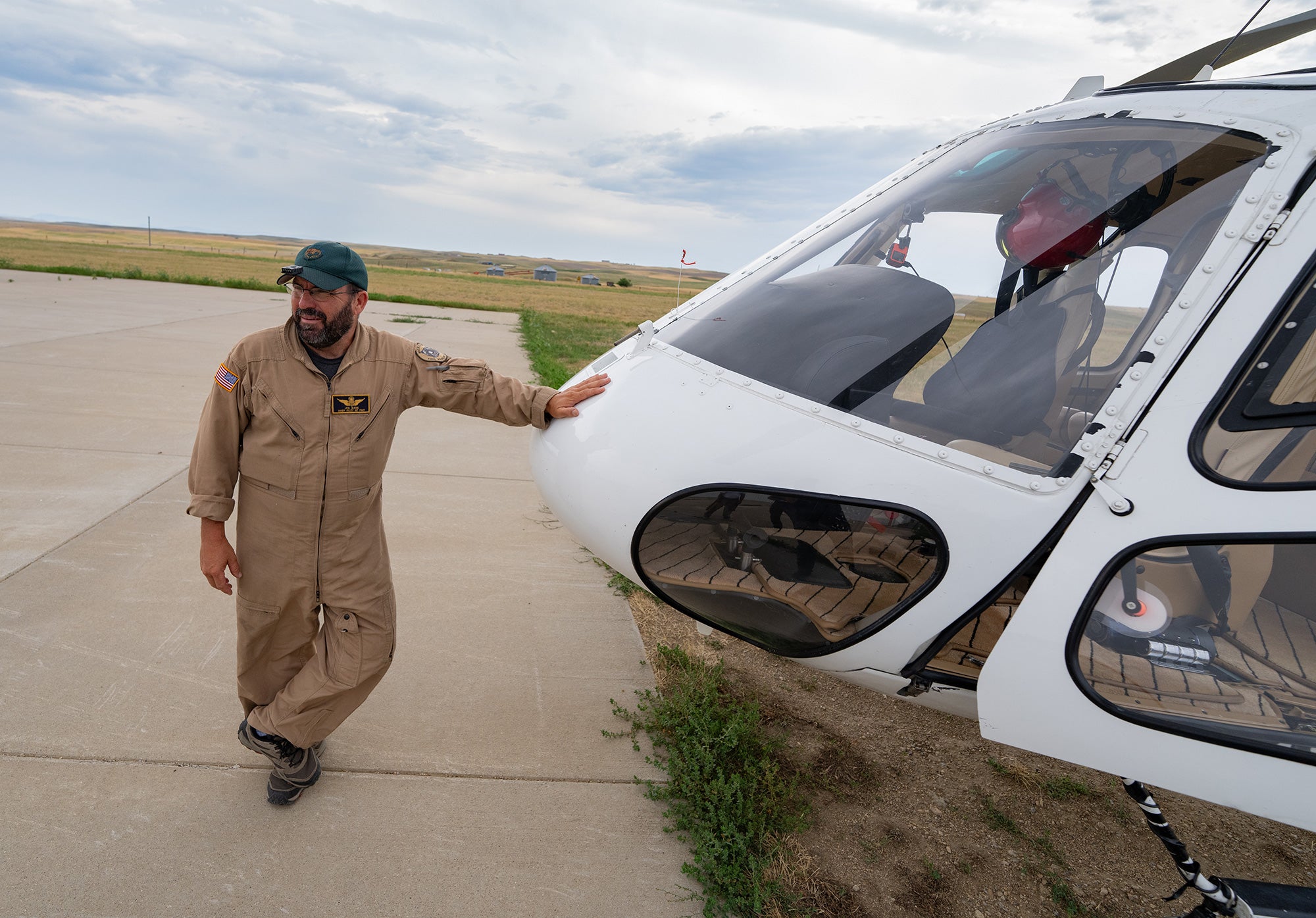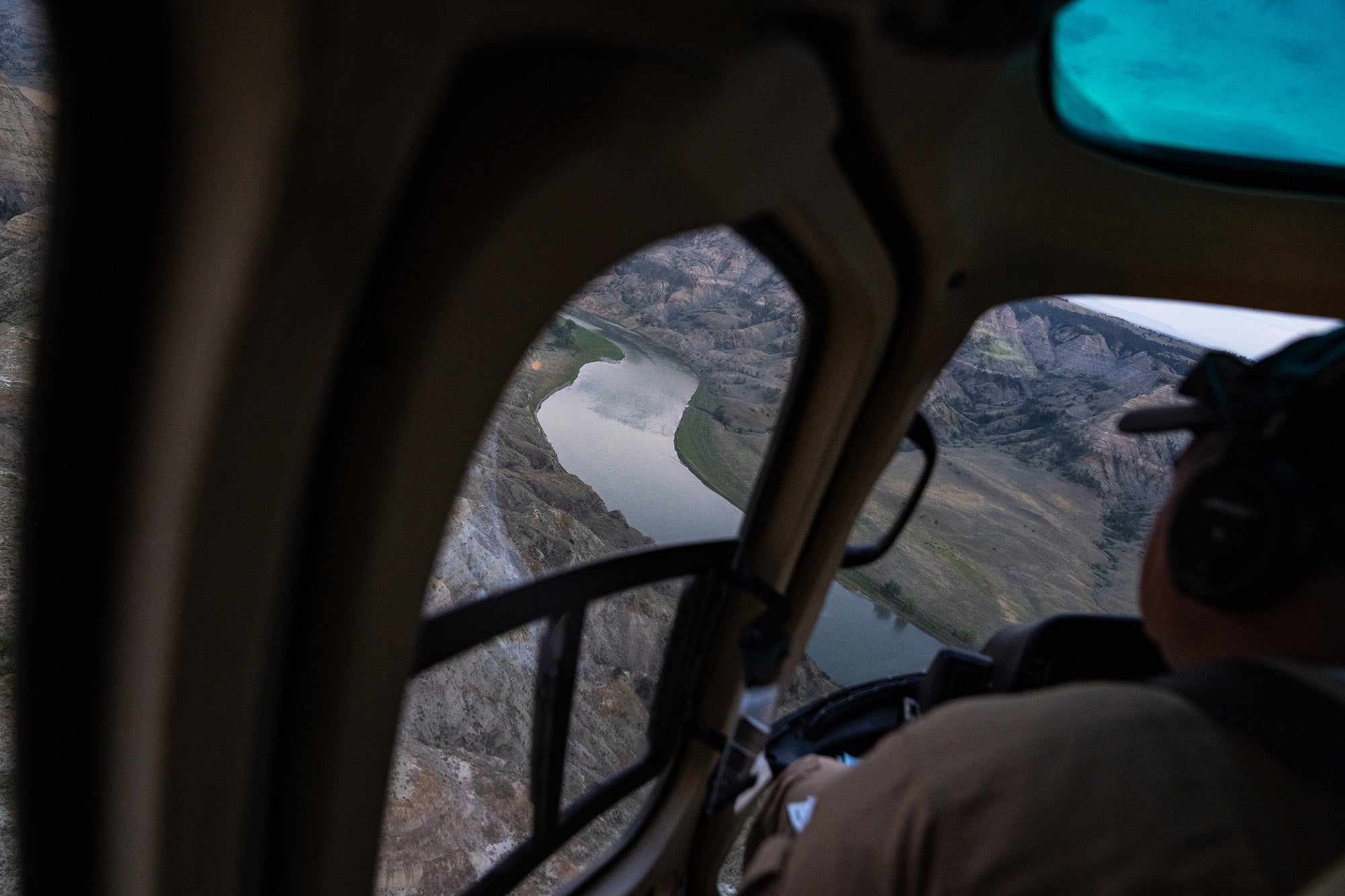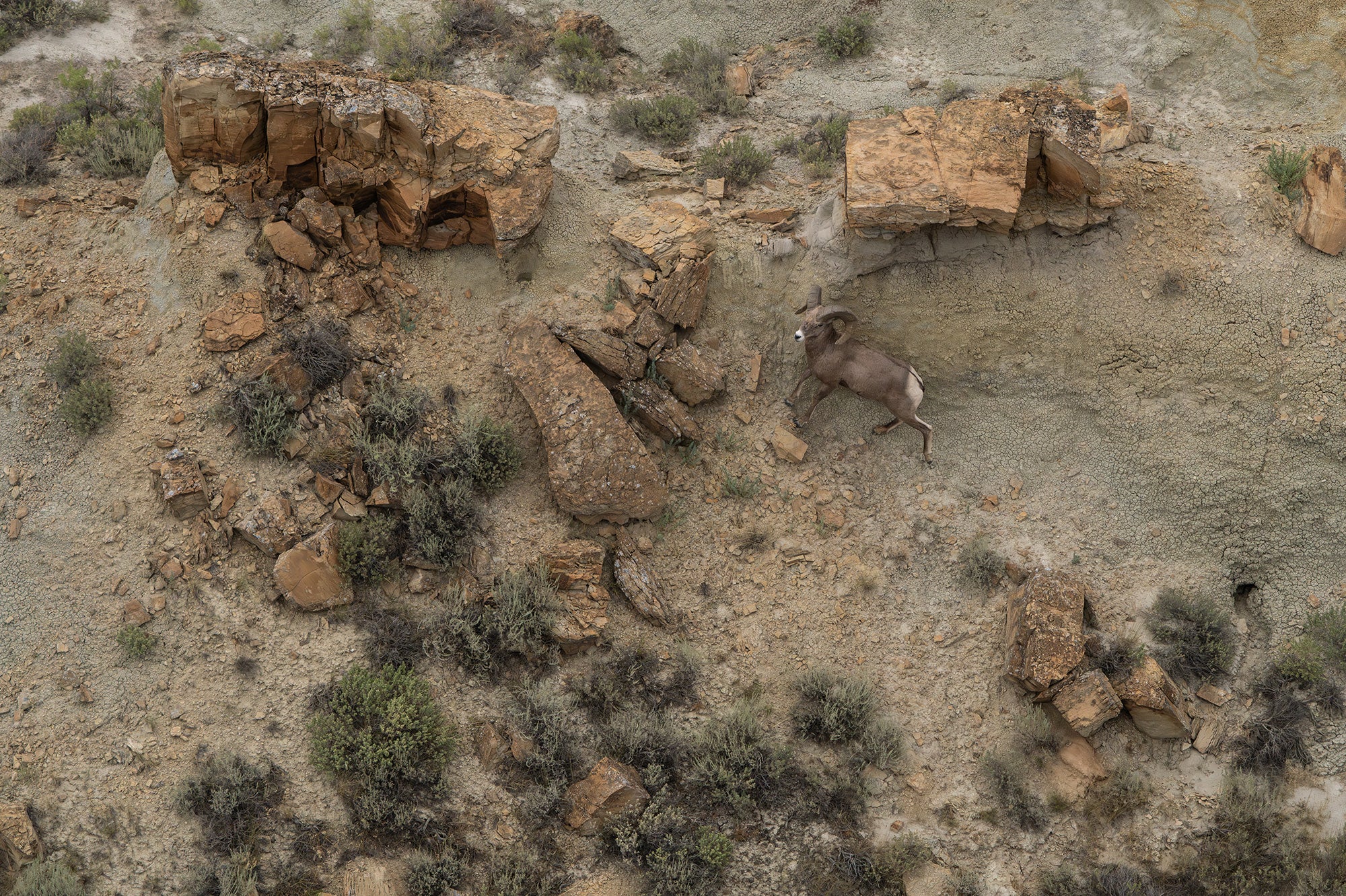Cockpit Conservation
The Aviation Unit of Montana Fish, Wildlife & Parks | Story by David Nolt. Photos by Zack Boughton.
It’s a warm and overcast day in Winifred, Montana. Zack Boughton and I roll into town and head to the tavern for a beer. We’re a half hour early for a helicopter flight with Montana Fish, Wildlife and Parks Pilot Joe Rahn, who will be flying us over the Missouri River Breaks on a bighorn sheep survey. We shoot the breeze with the bartender and roll the shake a day for a shot at the $500 pot. No dice.
 The Missouri River Breaks and Bears Paw Mountains.
The Missouri River Breaks and Bears Paw Mountains.
Joe gives us the go-ahead to meet, so we finish our beers and head across the street. It’s late July, and a summer squall is blowing through town with more than a few flashes of lightning and thunder. This is my first flight in a whirlybird, and these are not my ideal conditions. As excited as I am about the flight, the irrational thought of a lightning bolt and a microburst simultaneously striking our chopper down into a chasm in the Breaks has me gritting my teeth. I reassure myself: But what a way to go!
We head up to Joe’s hotel room and he greets us with a beaming smile. Short in stature but immense in his presence, Joe is the Aircraft Unit Bureau Chief/Chief Pilot for FWP’s Aviation Unit. He proudly tells us that Montana is the only state wildlife agency with its own fish, wildlife, and conservation air fleet. Joe and his fellow FWP pilots cover Montana’s 145,509 square miles in the name of conservation and recreation management.
“I’ve flown just about every inch of this state,” Joe says. “I love it.”
Joe’s dad was a marine pilot, and the apple didn’t fall far from the tree. After getting his fixed wing pilot’s license in Colorado, Joe joined the U.S. Army in 1991 and flew helicopters for the Army until 1995 when he joined the Montana Army National Guard. After earning his A&P Aircraft Mechanics degree in 1998, he and his wife moved to Alaska where he flew helicopters and airplanes all over the state for nearly a decade. He then joined the Alaska Army National Guard, flying the C-23 Sherpa airplane. In 2005, he was deployed to Iraq and served a yearlong tour flying the C-23 Sherpa. He eventually returned to Montana in 2007 when he joined Montana Fish, Wildlife and Parks. He became the Aircraft Bureau Chief in 2010, and now flies the Euro copter AS350 B2, Maule M-7 and PA-18 Super Cub.
Back in Joe’s hotel room, a strong gust of wind and a loud crack of thunder come through the open window.
“Is it windy?” he asks with slightly less concern than I’m feeling.
What defines “windy” for a helicopter pilot is beyond me. We relay the current conditions, but he appears unperturbed. If he’s not worried, I’m not worried.
 Montana Aircraft Unit Bureau Chief/Chief Pilot for FWP’s Aviation Unit Joe Rahn at the Winifred Airport.
Montana Aircraft Unit Bureau Chief/Chief Pilot for FWP’s Aviation Unit Joe Rahn at the Winifred Airport.
Zack and I sign our lives away and head down to the chopper. This is not just any chopper; the Airbus AS350 B2 (A-Star) is a sight to behold. Sleek, bright white with sharp gold stripes, and perched on the tarmac under its broad, curved blades, it’s an impressive machine. This seems like a sufficient whip for my inaugural helicopter tour.
Joe gives us the safety talk as Montana FWP Region 6 Wildlife Biologist Scott Hemmer arrives. We put on our headsets and board the back of the bird. Joe fires it up as the rotor slowly spins the blade into a whirring blur. After a few minutes of warmup and systems checks, we begin to rise into the air as the storm clears out.
Winifred sits on a long, yawning prairie bench just south of the Missouri River. It’s a mosaic of ranch land, dryland wheat fields, timbered ridges, and brushy draws that empty into the Breaks. The town comes into full view as Joe turns us north towards the river. Within minutes, we emerge over the cavernous coulees of the Breaks and cross the river to Region 6 as Scott and Joe begin their survey.
 Montana FWP Region 6 Wildlife Biologist Scott Hemmer conducting a bighorn sheep survey in the Missouri River Breaks.
Montana FWP Region 6 Wildlife Biologist Scott Hemmer conducting a bighorn sheep survey in the Missouri River Breaks.
The Breaks are home to healthy bighorn sheep herds and continually produce world-class rams. It’s classic sheep country, and rugged doesn’t even begin to describe the terrain. The Breaks are a legendarily wild place, packed with knife ridges, deep coulees, caves, scattered timber pockets, and eventually sweeping sagebrush flats that roll into cottonwoods and willows along the Missouri River.
As we scan the land below us, Joe informs the crew that he almost exclusively listens to “yacht rock radio” on his flights. Soon, the smooth grooves of Christopher Cross, Steely Dan and The Doobie Brothers wash over my ears, easing my aerial anxiety.
My gritting teeth ease up and turn into a grin as I think, “Damn, this Joe guy really knows how to set a vibe!”
It becomes immediately obvious that Joe is a total boss behind the helicopter’s flight controls. We are weaving in and out of intricate coulees at what seems like ten feet above the ground. Turning on a dime, leaving no stone unturned, he navigates this rugged country at crazy high speeds with an unbelievable calmness. Must be that yacht rock radio.
Suddenly, Scott and Joe spot a sheep. Joe banks the chopper nearly 180 degrees in seconds and my stomach lodges firmly in my throat. It’s a band of ewes, and we circle the area a handful of times as the sheep quickly traverse across impossible terrain, making it look effortless. Scott and Joe count a dozen ewes and lambs before we’re off to the next area.
 A young bighorn ram in the Breaks.
A young bighorn ram in the Breaks.
A native of Great Falls, Montana, Joe grew up hunting and fishing throughout central Montana and the Breaks. You can tell he loves this country.
“I think this is the true wilderness of Montana,” Joe says. “Hunting has been my life, and my passion for hunting and flying come together perfectly in this job. I’m really proud of our management of Montana’s wildlife, and I really value the hunter’s perspective. Hunters are the primary recreational users in this country, and they are such an important resource of knowledge about the land and wildlife. I actually approach these surveys a lot like I would a hunt.”
The Aviation Unit conducts aerial wildlife surveys in hunting districts across the state on an annual or biannual basis. This is crucial for maintaining healthy herds and setting accurate hunting quotas that can benefit as many hunters as possible without having net negative impacts on wildlife. The sheer size and ruggedness of much of Montana’s habitat makes aerial surveying the most reliable and accurate way to monitor wildlife. The Breaks are a perfect case in point.
“It’s such big country,” Scott Hemmer explains as we continue the search. “There are a lot of advantages of having our own internal aircraft unit. One of the primary benefits is the consistency it provides for the survey. I have flown with Joe since I started surveying bighorn sheep. The reliability of having a pilot that knows the country we are surveying, the best way to fly the area, and how to find sheep provides greater accuracy to our population data and allows the Department to do a better job managing both hunting opportunity and sheep populations.”
Hemmer says it doesn’t stop there.
“A second benefit is the amount of experience our pilots have. Their primary job is safely flying low-level wildlife surveys and the number of hours they spend in the seat of a helicopter or Supercub makes them experts at what they do. Although counting and classifying game is not their primary job, having another set of eyes experienced at identifying, counting, and classifying wildlife greatly improves the quality of a survey.”
 Bighorn sheep in Montana’s Spanish Peaks range.
Bighorn sheep in Montana’s Spanish Peaks range.
Hemmer and his fellow biologists use the terms “observability” and “sightability” to quantify their survey findings. These findings, which vary across the state’s species and habitat, factor in that it’s impossible to account for every single animal. While the surveys don’t give an overall estimate of the total population in an area, they are highly effective at identifying trends in a population, i.e. whether a herd’s population is trending up or down and what juvenile and mature male ratios are in comparison to the herd. Those trends are tied to the amount of tags offered to hunters.
Back across the river towards Winifred, FWP Wildlife Biologist Sonja Andersen manages Region 4. She goes so far as to say she couldn’t do her job without flying.
“Wildlife surveys are the bedrock of many of the decisions we make, and especially those that most immediately affect hunters,” Andersen explains. “While many of us spend a lot of time in the field, getting the ‘birds-eye-view’ of our districts and trend areas gives us a much more valuable perspective on not only animal numbers and sex and age structure, but also habitat conditions or other things going on the ground we might not otherwise see.”
In mountainous Region 3, FWP Biologist Julie Cunningham is responsible for surveying the wildlife surrounding Yellowstone National Park. She looks forward to every flight throughout the year.
 Montana Fish, Wildlife & Parks Region 3 Biologist Julie Cunningham on an aerial survey of bighorn sheep and Rocky Mountain goat.
Montana Fish, Wildlife & Parks Region 3 Biologist Julie Cunningham on an aerial survey of bighorn sheep and Rocky Mountain goat.
“I have a more thorough and detailed knowledge of the landscape and wildlife in my area because of our incredible wildlife pilots,” Cunningham says. “For many species, flying is the best way to get population counts and see the landscape while we are at it. We are seeing the body condition the animals are in, their behavior, how they group up, and we can classify the males, females, and young to learn about sex ratios and production or recruitment in a population. Flights help us cover large areas of public and private land that would be impossible to see in almost any other way.”
Each of the biologists emphasize that not only do the pilots make invaluable contributions to wildlife management, but they also do it safely and often in difficult conditions and terrain. I’m really feeling that reality as Joe rips down a coulee, cruises over the river at 150 miles per hour, then lifts up and over the Breaks back towards town with light fading.
Zack and I are both a little quiet and queasy in the back of the chopper towards the end of the flight, but it’s impossible not to smile after that experience. We’ve both spent a decent amount of time in the Breaks, but we likely saw the same amount of this country in a three-hour chopper tour as we have our entire lives.
 Montana FWP Aircraft Unit Bureau Chief/ Chief Pilot Joe Rahn holding court in the hangar after a survey in the Missouri River Breaks.
Montana FWP Aircraft Unit Bureau Chief/ Chief Pilot Joe Rahn holding court in the hangar after a survey in the Missouri River Breaks.
We had 147 gallons of fuel when we took off, and we touch down with 20. Joe and Scott batten down the bird and wheel it into the hangar as darkness creeps in over the prairie. The duo counted 68 sheep on this tour and head back out before dawn the next day. Scott counted a total of 289 sheep on his 2023 Region 6 surveys, and he estimates that number represents a total population of approximately 450 sheep. This data is integral to managing a robust herd and to guiding the upcoming hunting seasons, which directly impacts both sheep and hunters.
This story originally appeared in the 2024 Stone Glacier catalog.All in a day’s work for Montana’s FWP Aviation Unit. Inside the hangar, Joe cracks a seltzer water, takes a seat on his cooler, and regales us with tales about past days flying and hunting. These two worlds meshed perfectly for Joe, and Montana’s wildlife and hunters are better for it.

